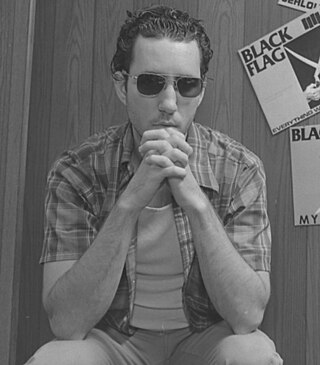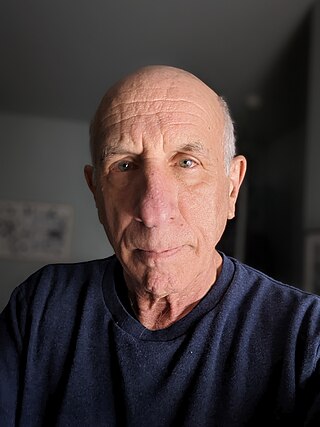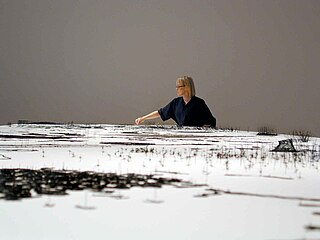
Raymond Pettibon is an American artist who lives and works in New York City. Pettibon came to prominence in the early 1980s in the southern California punk rock scene, creating posters and album art mainly for groups on SST Records, owned and operated by his older brother, Greg Ginn. He has subsequently become widely recognized in the fine art world for using American iconography variously pulled from literature, art history, philosophy, and religion to politics, sport, and sexuality.
Barbara Kruger is an American conceptual artist and collagist associated with the Pictures Generation. She is most known for her collage style that consists of black-and-white photographs, overlaid with declarative captions, stated in white-on-red Futura Bold Oblique or Helvetica Ultra Condensed text. The phrases in her works often include pronouns such as "you", "your", "I", "we", and "they", addressing cultural constructions of power, identity, consumerism, and sexuality. Kruger's artistic mediums include photography, sculpture, graphic design, architecture, as well as video and audio installations.

Kenneth Feingold is a contemporary American artist based in New York City. He has been exhibiting his work in video, drawing, film, sculpture, photography, and installations since 1974. He has received a Guggenheim Fellowship (2004) and a Rockefeller Foundation Media Arts Fellowship (2003) and has taught at Princeton University and Cooper Union for the Advancement of Art and Science, among others. His works have been shown at the Museum of Modern Art, NY; Centre Georges Pompidou, Paris; Tate Liverpool, the Whitney Museum of American Art, New York, among others.
Tara Donovan is an American sculptor who lives and works in Brooklyn, New York. Her large-scale installations, sculptures, drawings, and prints utilize everyday objects to explore the transformative effects of accumulation and aggregation. Known for her commitment to process, she has earned acclaim for her ability to exploit the inherent physical characteristics of an object in order to transform it into works that generate unique perceptual phenomena and atmospheric effects. Her work has been conceptually linked to an art historical lineage that includes Postminimalism and Process artists such as Eva Hesse, Jackie Winsor, Richard Serra, and Robert Morris, along with Light and Space artists such as Mary Corse, Helen Pashgian, Robert Irwin, and James Turrell.
Sarah Sze is an American artist and professor of visual arts at Columbia University. Sze's work explores the role of technology, information, and memory with objects in contemporary life utilizing everyday materials. Her work often represents objects caught in suspension. Drawing from Modernist traditions, Sze confronts the relationship between low-value mass-produced objects in high-value institutions, creating the sense that everyday life objects can be art. She has exhibited internationally and her works are in the collections of several major museums.

Alison Saar is a Los Angeles-based sculptor, mixed-media, and installation artist. Her artwork focuses on the African diaspora and black female identity and is influenced by African, Caribbean, and Latin American folk art and spirituality. Saar is well known for "transforming found objects to reflect themes of cultural and social identity, history, and religion." Saar credits her parents, collagist and assemblage artist Betye Saar and painter and art conservator Richard Saar, for her early exposure to are and to these metaphysical and spiritual practices. Saar followed in her parents footsteps along with her sisters, Lezley Saar and Tracye Saar-Cavanaugh who are also artists. Saar has been a practicing artist for many years, exhibiting in galleries around the world as well as installing public art works in New York City. She has received achievement awards from institutions including the New York City Art Commission as well as the Institute of Contemporary Art in Boston.
Kim Dingle is a Los Angeles-based contemporary artist working across painting, sculpture, photography, found imagery, and installation. Her practice explores themes of American culture, history, and gender politics through both figurative and abstract approaches.

Zoe Strauss is an American photographer and a nominee member of Magnum Photos. She uses Philadelphia as a primary setting and subject for her work. Curator Peter Barberie identifies her as a street photographer, like Walker Evans or Robert Frank, and has said "the woman and man on the street, yearning to be heard, are the basis of her art."
Wynne Greenwood is a queer and lesbian feminist performance artist who works in various media such as installation art, photography, filmmaking and music. One of her well known projects include the electropop and video project group, Tracy + the Plastics. Wynne works out of Seattle, Washington, and was an instructor in the Department of Art and Art History at Seattle University.
Chakaia Booker is an American sculptor known for creating monumental, abstract works for both the gallery and outdoor public spaces. Booker’s works are contained in more than 40 public collections and have been exhibited across the United States, Europe, Africa, and Asia. Booker was included in the 2000 Whitney Biennial, received a Guggenheim Fellowship in 2005, and an American Academy of Arts and Letters Award for Art in 2001. Booker has lived and worked in New York City’s East Village since the early 1980s and maintains a production studio in Allentown, Pennsylvania.

Anne Wilson is a Chicago-based visual artist. Wilson creates sculpture, drawings, Internet projects, photography, performance, and DVD stop motion animations employing table linens, bed sheets, human hair, lace, thread and wire. Her work extends the traditional processes of fiber art to other media. Wilson is a professor in the Department of Fiber and Material Studies at The School of the Art Institute of Chicago.
Michelle Stuart is an American multidisciplinary artist known for her sculpture, painting and environmental art. She is based in New York City.

Virginia Berresford was a painter, printmaker, and art gallery owner. Her works are exhibited in major galleries.
Peter Sarkisian is an American new media artist based in Santa Fe, New Mexico. He combines video projection and sculpture to create hybrid-format, multi-media installations.

Cady Noland is an American sculptor, printmaker, and installation artist who primarily works with found objects and appropriated images. Her work, often made with objects denoting violence, industry, and American patriotism, is primarily focused on the notion of the failed promise of the American Dream, the divide between fame and anonymity, and violence in American society, among other themes. Noland is also known for her numerous disputes and lawsuits with museums, galleries, and collectors over their handling of her work, as well as for her reluctance to be publicly identified, having only ever allowed two photographs of herself to be publicly released.
R. H. Quaytman is an American contemporary artist, best known for paintings on wood panels, using abstract and photographic elements in site-specific "Chapters", now numbering 35. Each chapter is guided by architectural, historical and social characteristics of the original site. Since 2008, her work has been collected by a number of modern art museums. She is also an educator and author based in Connecticut.
Jordan Wolfson is an American visual artist who lives in Los Angeles. He has worked in video and film, in sculptural installation, and in virtual reality.

Mary Miss is an American artist and designer. Her work has crossed boundaries between architecture, landscape architecture, engineering and urban design. Her installations are collaborative in nature: she has worked with scientists, historians, designers, and public administrators. She is primarily interested in how to engage the public in decoding their surrounding environment.

Patsy Ann Norvell (1942–2013) was an American visual artist who worked in sculpture, installation art and public art. She was a pioneering feminist artist active in the Women's movement since 1969. In 1972 she was a founder of A.I.R. Gallery which was the first cooperative gallery in the U.S. that showed solely women's work. Her work has been exhibited in galleries and museums in the U.S. and abroad. She received numerous grants, awards and residencies for her achievements, including the Pollock-Krasner Foundation and the National Endowment for the Arts. She created permanent public art works for the New York City subway system, designed and created lobby and plaza installations in Los Angeles, CA, New Brunswick, NJ, Bridgeport, CT, and Bethesda, MD. Her work has received historical and critical acclaim, and has been written about in books, journals and newspapers including, Art in the Land: A Critical Anthology of Environmental Art, in Sculpture (magazine), the Los Angeles Times, The New York Times and numerous other publications.

Michael Leslie Brewster was an American artist, recognized for coining the term “acoustic sculpture.” He worked with sound to create sonic environments beginning in the 1970s until 2016. His works were shown across the United States and Europe, and are in permanent collections, notably the Solomon Guggenheim Museum, the Fondo per Arte Italiano, Museum of Contemporary Art Los Angeles, and the Giuseppe Panza Collection.









